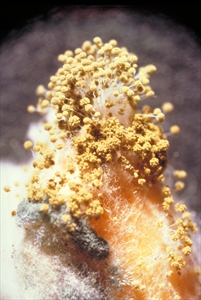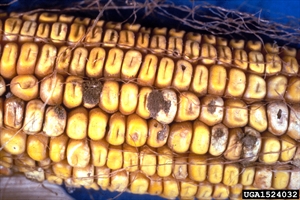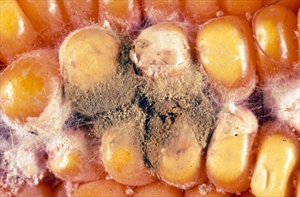Copra mould, Aspergillus ear rot (of maize), yellow mould of peanut, storage rot of groundnut.
Pacific Pests, Pathogens and Weeds - Online edition
Pacific Pests, Pathogens & Weeds
Coconut Aspergillus mould (233)
Aspergillus flavus
It is present in air, soils and water. Moulds of copra are recorded from Fiji, Samoa, and Solomon Islands.
Very wide; usually saprophytic (growing on dead organic matter, both plant and animal). Important as a post-harvest mould of maize, peanut and copra. In Fiji, it has been recorded as a neck rot of onions, but also on peanuts, maize and coconut, and in Solomon Islands it is recorded on discoloured and stored grains of rice.
A mould of seeds, grains and copra that have not been dried properly. Infection can occur in the field before harvest, or later, after harvest, during storage and transit. The fungus is most noticeable on stored copra (Photo 1), peanuts (Photo 2), maize (Photos 3&4), rice and other grains. Copra is turned a yellowish green, the colour of the spores of the fungus. The fungus can grow into seeds resulting in poor germination, and damaged seedlings. The disease is worse when insects damage the crop, and when plants are growing under stress.
In general, infections by Aspergillus flavus and aflatoxin production is more common in hot, dry years. In peanut and maize, for example, it is worse under conditions of drought, high temperatures (28-31°C), moist conditions with humidity of more than 85%, nitrogen deficiency (in maize), and insect damage. Insects, such as caterpillar borers and beetles, increase the amount of fungus and toxin for two reasons: (i) there is more damage for the fungus to colonise, and (ii) the damage releases moisture and that promotes fungal growth.
In peanuts, the disease is worse if there is moisture stress of more than 20 days near the end of the crop. It is worse, too, if the harvested crop is over mature, there is mechanical or insect damage to the pods, the moisture content of stored pods is great then 10%, or the peanuts are stored at high humidity.
The fungus survives in plant residues on or in the soil. Peanuts become infected from spores in the soil, and maize is infected by spores spread from plant debris to the silks of maturing maize ears by rain, wind, and also by insects. The fungus invades the kernels (seed), especially those that are injured. Some of the spores re-enter the soil at harvest, other spores stay with the ears to cause rots in storage.
The impact is from spoilage brought about by the fungus colonising stored products and its production of toxin. Under certain circumstances the fungus produces toxins - called aflatoxins - which affect livestock, particularly pigs and poultry, as well as human beings. Aflatoxins can have a major impact on the value of the commodities susceptible to Aspergillus flavus.
In livestock, aflatoxin causes liver damage, reduces reproduction, reduces milk or egg production, causes birth defects, tumours, and weakens the immune system. In humans, it causes high fever, jaundice, oedema (water retention) of limbs, vomiting, swollen liver, and hepatitis.
Throughout the world, aflatoxin causes a huge problem to human and animal health as well as crop production. Wherever surveys have been done on peanuts or maize, they have found levels of contamination between 30-40%.
Look for a greenish-yellow mould on copra or on seeds that are discoloured and rotten.
CULTURAL CONTROL
Before planting:
- Plant peanuts at recommended spacing: about 30 plants per m2.
During growth:
- Ensure adequate nutrition. Apply fertilizer at recommended rates, or farmyard manure (5-10 t/ha).
- For peanuts, avoid end of season drought, if possible, by irrigating the crop.
- For peanuts, remove dead plants from the field before harvest.
- Harvest crops at the right stage of maturity. Harvest maize when all the leaves are dry and the cob turns down (ready for shelling). Harvest peanuts when most have seed coats that have changed from white to dark pink, and the internal shell colour darkens.
After harvest:
- For peanuts, turn the peanut plants upside down after harvest and allow to dry for 3-5 days.
- Dry to the following moisture contents: peanuts below 8%; maize 13-15% within 24-48 hours of harvest; and copra to 5-7% (until it is brittle and breaks easily).
- Remove pods immediately after drying, fill bags and store in well-aerated, waterproof place.
- Prevent insect damage to copra, peanuts and maize kernels.
- Rotate crops, leaving a 3-4-year interval between crops of maize or peanuts planted on the same land. Rotations with vegetables or rice would be suitable crops to reduce soil populations of Aspergillus flavus.
RESISTANT VARIETIES
There are peanut and maize varieties that tolerate Aspergillus flavus infection, but which do not support the production of toxins.
CHEMCIAL CONTROL
Treat seed with mancozeb (3g/kg) before planting. It is important to control insects during growth of the crop, in particular, caterpillars, termites, and beetles.
____________________
When using a pesticide, always wear protective clothing and follow the instructions on the product label, such as dosage, timing of application, and pre-harvest interval. Recommendations will vary with the crop and system of cultivation. Expert advice on the most appropriate pesticides to use should always be sought from local agricultural authorities.
AUTHOR Grahame Jackson
Information from CABI (2015) Aspergillus flavus (Aspergillus ear rot). Crop Protection Compendium. (https://www.cabi.org/cpc/datasheet/7432); and from Mycotoxins. World Health Organization. (https://www.who.int/news-room/fact-sheets/detail/mycotoxins). Photo 1 Kohler F, et al. (1997) Diseases of cultivated crops in Pacific Island countries. South Pacific Commission. Pirie Printers Pty Limited, Canberra, Australia; Photo 2 Aflatoxin in peanuts. Department of Agriculture and Fisheries, Queensland Government. Photo 3 Department of Plant Pathology Archive, NCSU, Bugwood.org.; Photo 4 Harry Duncan, NCSU, Bugwood.org.
Produced with support from the Australian Centre for International Agricultural Research under project PC/2010/090: Strengthening integrated crop management research in the Pacific Islands in support of sustainable intensification of high-value crop production, implemented by the University of Queensland and the Secretariat of the Pacific Community.







